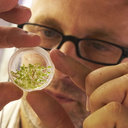HRE-type genes are regulated by growth-related changes in internal oxygen concentrations during the normal development of potato (Solanum tuberosum) tubers.
Keywords
Abstract
The occurrence of hypoxic conditions in plants not only represents a stress condition but is also associated with the normal development and growth of many organs, leading to adaptive changes in metabolism and growth to prevent internal anoxia. Internal oxygen concentrations decrease inside growing potato tubers, due to their active metabolism and increased resistance to gas diffusion as tubers grow. In the present work, we identified three hypoxia-responsive ERF (StHRE) genes whose expression is regulated by the gradual decrease in oxygen tensions that occur when potato tubers grow larger. Increasing the external oxygen concentration counteracted the modification of StHRE expression during tuber growth, supporting the idea that the actual oxygen levels inside the organs, rather than development itself, are responsible for the regulation of StHRE genes. We identified several sugar metabolism-related genes co-regulated with StHRE genes during tuber development and possibly involved in starch accumulation. All together, our data suggest a possible role for low oxygen in the regulation of sugar metabolism in the potato tuber, similar to what happens in storage tissues during seed development.


